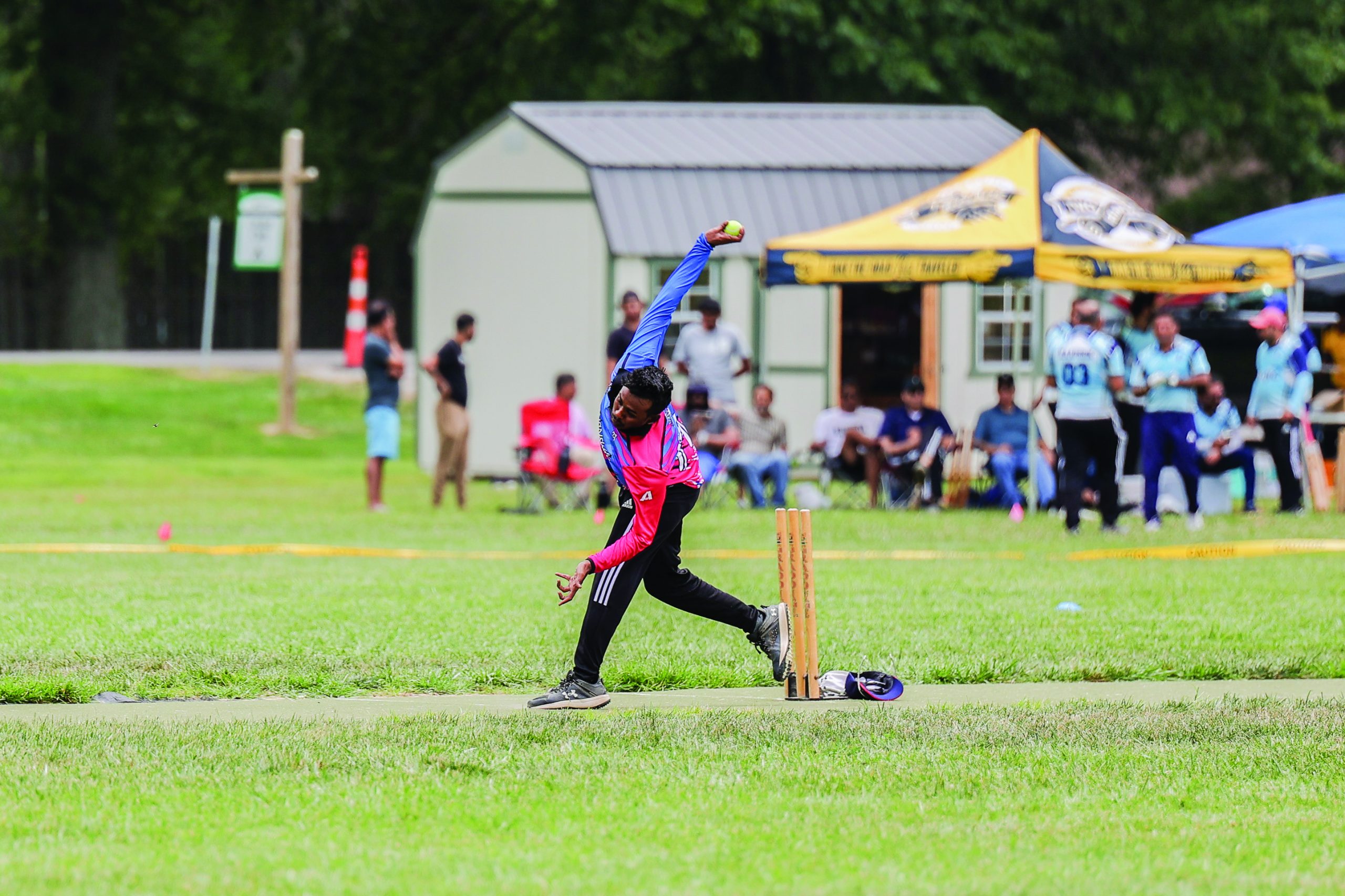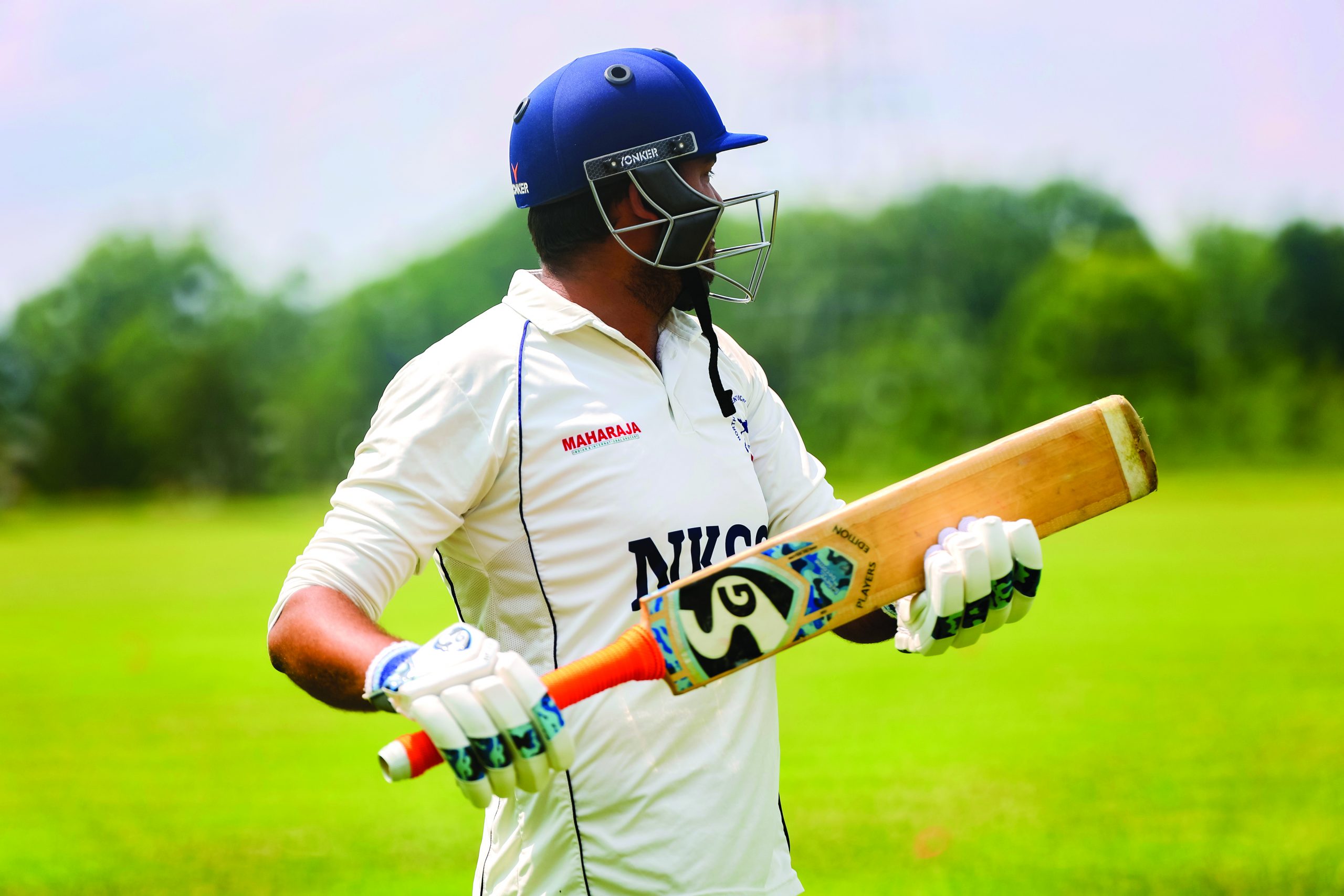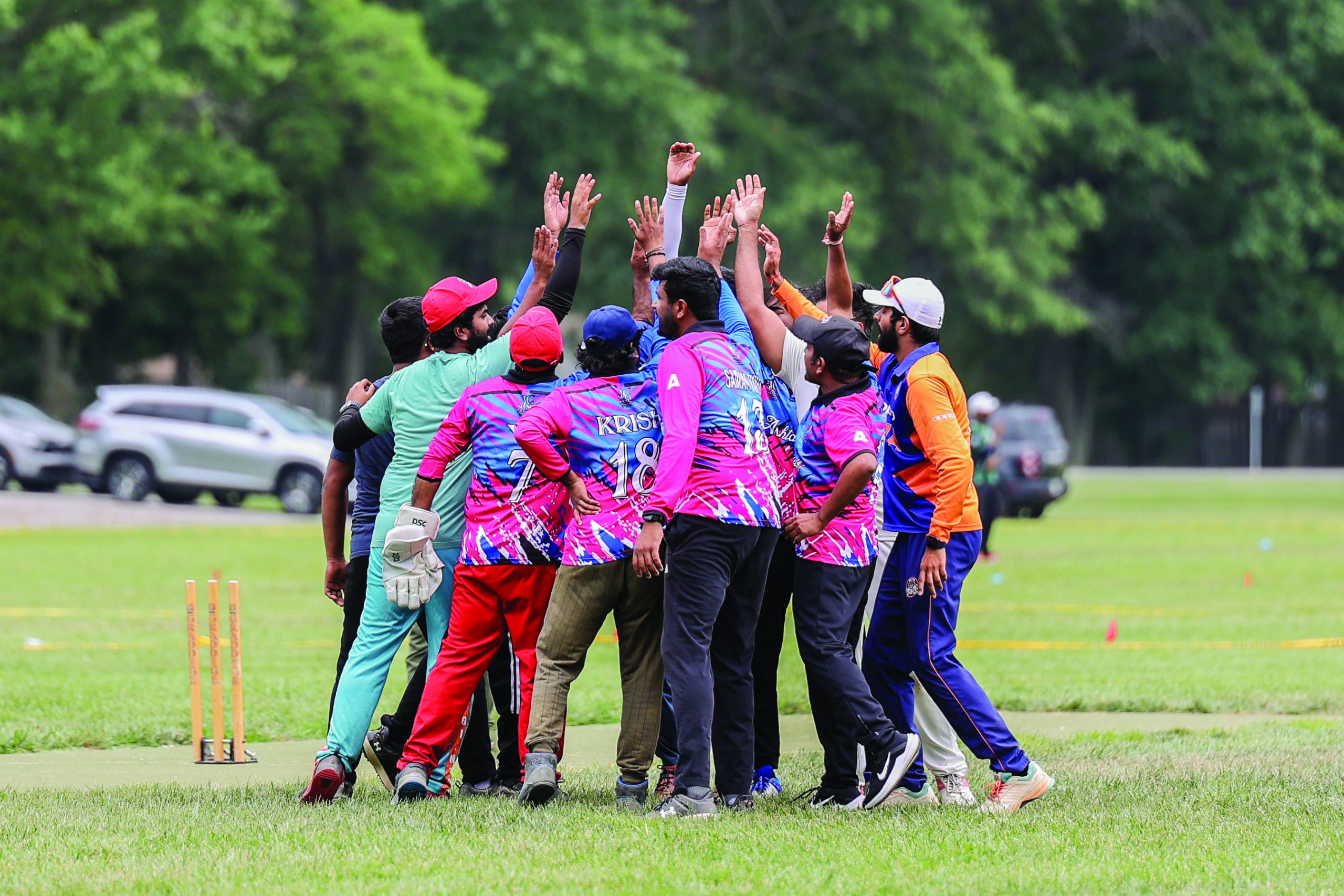Photograph by Emily Christy
Like a passenger jet screaming down the runway, the bowler sprints down the pitch before releasing the ball with a backward 360-degree arm motion resembling a medieval trebuchet heaving a giant boulder against a castle wall. The crouching batter holds his flat-faced weapon somewhere between his knees and the ground, looking like a hockey goaltender defending his net.
The bowler’s pitch hits maybe 10 feet in front of the hitter and skids sharply toward the batter and three vertical sticks behind him. The hitter swings, and the ball careens foul. The catcher dives to his right, snaring the ball in his bare hand for a catch Tyler Stephenson would appreciate. His teammates—the other 10 men in the field—break ranks, erupting in joy as they mob their catcher, celebrating one of the 15 “overs” they’ll need to win the match.
Confused? This is cricket, arguably the second most-played sport on the planet after soccer. It’s almost a religious experience in Pakistan, Sri Lanka, Australia, England, and India. And maybe in Clermont County’s Miami Meadows Park on this Sunday afternoon.
Cricket originated in southeast England as far back as the late 1500s and was invented, historians believe, by children who played on sheep-grazing fields using a lump of matted wool as a ball and a farm tool as a bat. It took adults a few decades to pick up the sport, but they then exported it across the expanding British Empire. Cricket caught on in the West Indies, the Asian subcontinent, Australia, New Zealand, and South Africa; despite being introduced to the American Colonies, the sport never became a national obsession in the U.S.
Cricket was popular in Cincinnati in the mid-1800s, brought here by English immigrants, but “town ball” (what we now know as baseball) would take over cricket grounds and the public’s fancy after the Civil War. George and Harry Wright first came to Cincinnati as cricket players before forming the Cincinnati Red Stockings in 1869.
“This is a great place to play,” says Maulik (Max) Patel, unofficial commissioner of the Miami Township Cricket Club, as he surveys the 20-acre field on a cloudless afternoon. There are shouts from the far end near a tree line as a team from Dayton scores a run. On another field, two players are disputing the call from an umpire who, just like in baseball, gives no quarter. “We can run four matches at the same time and, as you can see, there are a lot of people from all over the area who want to play,” Patel says.

Photograph by Emily Christy
There are 27 teams in this league with up to 15 players on each team, proving his point. The rainbow of brightly colored uniforms on the field represents teams from Columbus, Louisville, Dayton, Northern Kentucky, and other locales around the tri-state. The Cincinnati Premier League is dominated by players of Indian heritage, many of whom are related to one another. On this summer afternoon, talk is about the U.S. cricket team, which had just stunned perennial powerhouse Pakistan in the group stage of the T20 World Cricket Championships. Patel hopes the national team’s success might give the game a renewed spark in the U.S.
It reminds him of how cricket took recent root in the Cincinnati area. In 2011, Patel recalls, the Indian community here was “full of excitement and patriotism” when India won the World Cup (as they did this year). “Everyone wanted to play,” he says, laughing. The league, at the time, had 50 or so participants and had been playing its matches for several years at Sharon
Woods. But those fields weren’t up to cricket standards, and there was no way the space could accommodate what was likely to be an explosion of interest the following season.
“I took my kids to Miami Meadows and saw this,” says Patel, gesturing at the expansive field and then laughing as I move quickly out of the way of a solidly hit fly ball. He knew right away that this could be home. The plot of land was devoid of trees and had once been used as a polo field. It was near the front entrance to the park off Ohio Route 131 and, for the most part, had served only as an overflow parking lot for special events.
Patel is an ideas person with the personality, organizational skills, and energy to make things happen. Armed with a winning smile and a plan, he approached Miami Township Trustee Mary Wolff with a proposal for a public-private partnership.
Wolff was intrigued, seeing the opportunity for turning a troublesome piece of parkland into something both usable and unique. “We were grateful for the donation of the land,” she recalled on a Miami Township video, noting the acreage was a former wetland with challenging drainage issues “but, you know, sometimes donated land isn’t the best land.” The township, Wolff said, appreciated the hard work of the cricket club volunteers to make the field playable and enhance the park’s usefulness.
Hard work and money. Patel says the principal leaders of the cricket club—about 50 or so members—have invested more than $150,000 of their own money “and countless hours” over the last decade or so adding and raking topsoil to eliminate ruts and level the fields. The township budgeted funds to extend a gravel parking lot, aerate, and overseed. The township mows the fields to the same length as the rest of the park.
“They’ve done the majority of the work either themselves or contracting for it,” says Steve Kelly, the township’s administrator. “The water table here is very high, so it’s a lot of work, but the club members work even harder. This is a great partnership.”

Photograph by Emily Christy
There’s another sudden shout from the field as a ball that, in baseball, would be foul is launched into what we Yanks would call right field. In cricket, there’s no such thing as a foul—the game is played on a circular space with the batter and pitcher (called a bowler) facing off in the center.
But wait: The batter isn’t the only man running as the fielder scrambles to retrieve the ball. There are actually two runners (and batters) on the field, and they run toward each other down a 22-yard runway (called the pitch) to each other’s ends. If they make it to the opposite end of the runway before the fielder “puts down a wicket,” they score a run. If not, the runner nearest a downed wicket is out or, as it’s said here, “dismissed.”
A wicket? These are three stumps pounded into the ground in between the batter and the catcher on each end of the runway. The bowler will try to knock down those wickets to cause an out, which is why sometimes the batter looks like a hockey goalie fending away the pitches.
On the other hand, the batter isn’t always playing defense. If he’s quick enough and strong enough, he can belt one past a scattering of orange flags that line the radius of the field, which is a “boundary hit” worth an automatic six runs. Just like Ken Griffey Jr. used to do, the batter can watch his blast with admiration. It’s worth six runs, and he doesn’t even have to run.
The local league’s games typically last up to two and a half hours, but matches in international play can go up to five days. “That wouldn’t work here,” Patel says, laughing. “We all have jobs.” In cricket, a side isn’t retired with three outs. Everyone gets to bat in an innings (it’s always plural in cricket) and does so until he’s dismissed.
Another term unique to cricket is an “over.” That’s a group of six deliveries by the pitcher to the batter. The pitches are typically bounced off the runway and must arrive below the batter’s waist. One of the recent improvements the cricket club added to each of the four Miami Meadow fields was a turfed pitch laid over concrete, allowing for a truer bounce.
“Sometimes the ball can slow down or skid and pick up speed when it hits the turf,” Patel says as he holds a cricket ball—similar a tennis ball, but as hard as a baseball. “When it bounces, you’re putting doubt in the batsman’s head because he doesn’t know how you’ve pitched it.” Like baseball pitchers, cricket bowlers use different speeds and grips to confuse their opponent.

Photograph by Emily Christy
“Winning the coin toss that starts a game can be important,” Patel explains as he hands me a penny. Typically, the team that wins the toss elects to have its opponent bat first so they know, when it’s their turn, what they’ll need to score to win. Indeed, the team that correctly calls “heads” erupts in jubilation when my toss reveals Lincoln’s profile poking through the grass blades.
Walking the Miami Meadows cricket fields on a Sunday afternoon is a unique linguistic experience. While Hindi is the official language in India, in truth there are more than 100 other major languages spoken on the subcontinent. “We have a lot of them here on the field,” Patel explains, noting the common languages everyone understands on the pitch are English and Hindi.
Patel himself moved to the U.S. in 1998 from Ahmedabad, a city of more than 7 million in western India. He was 8 years old and, like many Indian immigrants who have located here, arrived in Cincinnati to join members of his extended family who had immigrated earlier in the decade.
According to the 2020 U.S. census, 2.7 million Indians form the second largest immigrant group in the U.S., trailing only those from Mexico. The growth has been exponential, especially since 2010, when persecution of non-Hindu Indians became more widespread. More than a million Indians moved to the U.S. in the teens, and the trend shows no sign of slowing.
That trend is reflected locally. Ohio’s Indian population increased 58 percent from 2010 to 2020, and our corner of the state led the way: Hamilton County up 61 percent, Clermont 48 percent, Butler 79 percent, and Warren 109 percent. The largest local population of Indian immigrants lives in Mason’s 45040 Zip code.
“Many of us came to the United States through another country even though we originated in India,” Patel says of the players on the cricket field. “Some came from Africa, some through Canada or England, but we settled here because Cincinnati has both a great lifestyle and business opportunities at the right price.”
The cricketeers in their colorful uniforms that Sunday afternoon, he notes, may be coding, developing websites, analyzing data trends, or working on network security when Monday rolls around. About 85 percent of the players, he says, work in IT. Most are highly educated—some in U.S. universities, others from overseas institutions—and are, he acknowledges with a laugh, workaholics.
Patel himself is a self-described entrepreneur with investments in hotels, convenience stores, restaurants, and gas stations. “I am surrounded by that entrepreneurial mindset,” he says of his family. Growing up, he watched as they started the chain of business investments from Ameristops and Holiday Inns to Dunkin’ Donuts and Subways, and now he and his brother run the show. “It’s not the easiest, but it’s the way to get ahead.”

Photograph by Emily Christy
That American grab-the-bull-by-the-horns attitude translates to Patel’s management of the cricket club. Three years ago, responding to the sport’s growth here, he and the township agreed to establish more cricket fields, making Miami Meadows Park the largest cricket complex in the entire state.
The expansion, Patel says, allows for more teams to play, many of which travel here from out of town to compete in weekend tournaments. Last year, teams from all over the region drove or flew to Cincinnati to play a weekend tournament that was live-streamed through Facebook back to eager fans and family members in India.
Not lost on Miami Township officials is the potential economic impact of what is quickly becoming a cricket tourist stop. “We’ve seen a huge surge of people coming into the township to play and, in some cases, stay for the weekend,” notes Kelly. “We’re working with the county, the chamber of commerce, and [economic development agency] REDI to market this league as a value-added activity.” Local restaurants and hotels, he hopes, will become the immediate beneficiaries of cricket’s growth.
Kelly says companies looking to locate or expand in Clermont County are always asking what amenities their employees can enjoy locally. With Indian-owned Tata Consultancy Services one of Miami Township’s largest employers, cricket is a winner.
Aayush Patel (no relation to Maulik) is only 23, but he’s already captain of one of the league’s teams. Born in India, as he says, “with a bat and ball in my hands like everyone else,” his family immigrated to Cincinnati six years ago. The transition to American life was a challenge—he calls it “hectic” here—but the opportunity to play the national sport in an organized league just minutes from his Symmes Township home was a godsend.
A junior at the University of Cincinnati, where he’s majoring in information systems, Aayush says cricket is both a stress-reliever and a teacher. “Playing the game helps you make good decisions in life,” he says. “How to bowl, where to play your position, when to be aggressive, how to assess a problem—all good things to learn that will help you.”

Photograph by Emily Christy
As a practical matter, he says, just as American kids make friends playing Little League baseball, he’s made friends from all over the region through the cricket league. It’s helped him adjust quickly to life in America while keeping a connection with traditions back home.
The league’s future looks bright at Miami Meadows. It’s hosting a major tournament involving teams from all over the Midwest, beginning August 17. JC Soni, a Sharonville jeweler and generous funder, recently erected a small equipment shed on site, and the league is now talking with the township about building a multi-sided gazebo that would have sight lines to all the fields. There is room for a fifth field, but the township first plans to seek a 1-mil property tax levy from voters that, if approved, would create a master plan to determine how best to utilize the park’s remaining acres.
The fields are a swarm of activity as four games play out simultaneously. Orange flags dot the grass to separate the fields, but you need to watch ahead of you and behind you because balls and people are flying everywhere. Maulik Patel, himself an occasional player, takes it all in with an ear-to-ear smile on his face and laughs, reminding me of that first lesson: It’s a game played in the round.
“It’s really a very simple game,” he says. I agree. But maybe it’s more like games, plural: a little bit football, a little bit baseball, a little bit hockey. And a lot of joy.
